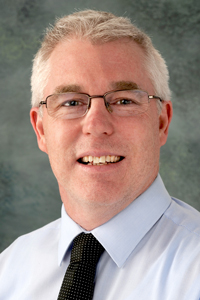
Dr Glen Kennedy
The rapidly evolving field of CAR T-cell therapy is likely to see indications extend to other lymphomas beyond diffuse large B-cell lymphoma (DLBCL), a leading haematologist says.
There is also the prospect of CAR T-cell therapy being used earlier in the course of DLBCL, according to Dr Glen Kennedy, a haematologist and director of Cancer Care Services at Royal Brisbane and Women’s Hospital (RBWH).
Speaking in a webinar to mark World Lymphoma Day, Dr Kennedy said current second generation CD19 CAR T-cell therapies have already transformed outcomes for the 30% of patients with DLBCL with relapsing or refractory disease who would previous have been considered to have terminal illness.
Real world studies have confirmed that patients with DLBCL who have complete remission with CAR T-cell therapy show durable responses, with overall survival rates of around 50% at up to two years.
“Because of these results there are now several studies exploring the efficacy of CAR T-cells not so much in multiply relapsed or refractory settings but earlier in the disease course when patients have initial refractory disease or initial relapse, comparing the efficacy with autologous stem cells transplantation (ASCT),” he said.
The results are expected in the next 12-24 months.
Attention is also focusing on other lymphoma subtypes, with supportive data and active trials taking place for multiple other B-cell malignancies such as Mantle Cell Lymphoma, Follicular Lymphoma and Chronic Lymphocytic Leukaemia.
“There is also encouraging data for CD30 CAR T-cells in relapsed/refractory non B-cell-lymphomas including classic Hodgkin’s lymphoma and even anaplastic large cell lymphoma,” said Dr Kennedy.
He cited the example of a complete response rate of 59% seen in Hodgkin’s lymphoma and PFS of 36% at 12 months.
And although not strictly a lymphoma, there is also supportive data for BCMA CAR T-cells to treat multiple myeloma.
But the wider use of CAR T-cell therapy needs to overcome multiple challenges, including the affordability, technical issues of manufacture and reinfusion and side effects such as cytokine release syndrome and immune effector cells associated neurotoxicity (ICANS). There are also issues round identifying ideal candidates for CAR T-cell therapy and predicting relapse and refractory responses, he said.
A further challenge is ‘tumour escape’ after CAR T-cell therapy due to PD L1 escape and CD19 antigen loss. Several approaches to circumvent this are now being explored, including combining CAR T-cell therapy with immune checkpoint inhibitors or targeted therapies such as BTK inhibitors, and the development of ‘fifth generation’ dual-antigen CAR T-cells.
“The place of CAR T-cell therapy in lymphoma is rapidly evolving in line with the demonstrable benefit in different lymphoma subtypes,” Dr Kennedy concluded.
And despite the numerous obstacles, “developments in manufacturing techniques, CAR T-cell technology and patient selection will go a long way to promote broader use and access to CAR T-cells to more patients in need,” he said.